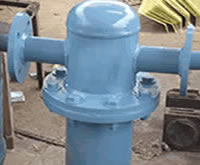Vertical Shell and Tube Heat Exchanger
Introduction
Vertical Shell and Tube Heat Exchanger in which the tubes extend through over sized holes in a liquid distribution plate. Liquid flows through the holes and down each tube exterior surface as a falling film. A spacer or clip, desirably of wire, is placed in each hole around each tube to center the tube so that the film has a uniform thickness. A set of tubes is called the tube bundle and can be made up of several types of tubes; plain, longitudinally finned, etc. Shell and tube heat exchangers are typically used for high-pressure applications with pressures greater than 30 bar and temperatures greater than 260. This is because the shell and tube heat exchangers are robust due to their shape.
Specifications:
- It is widely used in variety of application as a cooling solution.
- The most common among them is for cooling of Hydraulic Fluid and oil in engines, transmissions and hydraulic power packs.
Applications:
- The clip is self-locking and remains fixed securely in position.
- It is a heat exchanger that is derived from its parent Shell and Tube Heat Exchanger and it is most commonly all Industries which involves higher-pressure and Higher Temperature applications.
Advantages:
- It consist of a series of tubes. The fluid that must be either heated or cooled.
- That second fluid runs over the tubes that being heated and cooled so that it can either provide the heat or absorb the heat required.
Features:
Shell and Tube Heat Exchanger is the most widely recognized sort of warmth exchanger in oil refineries and other huge concoction forms, and is suited for higher-weight applications. Shell Tubes Heat Exchanger are arranged into settled and Floating compose Heat Exchangers. Settled compose Heat Exchangers are utilized where there are definitely no odds for bury blending of two liquids.
Images:


